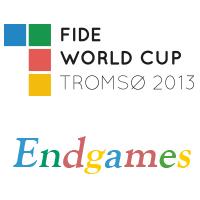
The Endgames of Tromsø, Part 3
This week I will continue with the third installment of my series on the endgames played in the World Cup, currently taking place in Tromsø, Norway.
One of the biggest surprises of the third round was top seed Levon Aronian's elimination at the hands of Evgeny Tomashevsky. In the first game of their mini-match, Tomashevsky succeeded in winning with black, outplaying his opponent to reach an ending with opposite-colored bishops and an extra pawn. We will begin by looking at that ending:

Tomashevsky is having a great result - at the time of writing he has defeated Alexander Morozevich and Gata Kamsky in the two matches subsequent to the one with Aronian.
Le Quang Liem also defeated his higher-rated opponent, Alexander Grischuk. In the first game he won a won a pawn ending with an equal number of pawns. However, it was clear that White's protected passed pawn made the ending hopeless for Black - let's see the finish to that game:
However, in the second game of their match, Grischuk managed to equalize the score, using incredible determination and fighting spirit to win a 154(!) move game. I had been watching the game live for a while, but stopped at some point when it seemed that a win by White was very unlikely. I was quite surprised when later I saw that Grischuk had managed to win.
The tiebreak, however, went to Le Quang, who advanced to round four.

Both of Hikaru Nakamura's games with Baskaran Adhiban were contested in queenless middlegames. In both games Nakamura completely outclassed his opponent, and both games were impressive and instructive:
Both games were great demonstrations of simple chess. Many chess fans see Nakamura as only a crazy tactician, but these games show that a nearly 2800-rated player is more complex than that.

Boris Gelfand quickly won a queenless middlegame against Alexander Moiseenko, by putting pressure on precisely the right points in the black position. This chess Jiu-jitsu quickly caused his opponent to shed material:
Alexander Morozevich missed an opportunity to win with black against Nikita Vitiugov. He had an overwhelming advantage but created some problems for himself in realizing it. Finally he was still winning, but losing one tempo was enough to allow his opponent, who constantly found the only moves, to save the game.
In the second game of their match, Morozevich surprised spectators by agreeing to a thirteen move draw with White. However, I think this was a conscious sporting decision, to wipe away the negative feelings from the missed opportunities in the above game, and begin the match anew in the tiebreaks, which he ended up winning.

In two other games, one player was trying to equalize the score after having lost the first game of the match. Lenier Dominguez had good chances to do so in a minor piece ending where his bishop was stronger than the black knight. However, one inaccuracy allowed Vachier-Lagrave to consolidate the position and obtain the needed draw.

Meanwhile, famous natural talent Julio Granda Zuniga did succeed in winning his game with black and equalizing the match after his tragic blunder in a winning position in the first game. In a queenless middlegame with a King's Indian structure his pieces succeeded in finding the right outposts and a nice combination decided the game on the queenside.
Photos by Paul Truong
RELATED STUDY MATERIAL
- Read Part 1 & Part 2 of The Endgames of Tromsø;
- Watch by GM Dejan Bojkov's Opposite Colored Bishop Endgames: With Rooks;
- Read Iryna Zenyuk's article The Arch-Arch-Nemeses: Bishop vs. Knight.






